Kitasaga High
My School Days in Kyoto-city.
By Yuki Hayata
September 7, 2003
[EDITOR'S NOTE: Ms. Hayata, a former student in the Intensive English Program, is a graduate of the University of Central Arkansas. Today she is a graduate student in music at UCA. Ms. Hayata is a dedicated writer and contributor to Planet IEP. She is also adventurous, curious, talented. We can learn a lot about Japanese High School from her story. Thanks again, Yuki, for another wonderful narrative.]
Racing to School....
No Suspension for Yuki!
My home town Kyoto-city (Kyoto Prefecture, Japan) is in the Kinki region located in west central Honshu, the main island, and consists of Osaka, Hyogo, Kyoto, Shiga, Mie, Wakayama, and Nara prefectures. Kyoto was the ancient capital of Japan from 794 to 1868, and is now one of Japan's largest cities with a population of about 1,400,000. The city is known as an educational and cultural center with 40 universities and private institutes of higher learning, 24 museums, 202 National Treasures, and 1684 Important Cultural Properties.
My high school, Kitasaga High School, is a public school located in northwest Kyoto in the Ukyo District (Ukyo-ku). The area around Kitasaga High is designated as one of the Important Cultural Properties, consisting of Hirosawa Pond and Daikakuji Temple.
 In the morning around 8:15 a.m., the streets near Kitasaga High are very crowded with many students, who are riding bicycles and rushing to go to school. According to school rules, students must arrive no later than 8:30 a.m.. If a student comes after 8:30, teachers who are standing at the gate will give them a ticket for being late. After receiving some tickets, a student will be called-in by the principal. After so many tickets, a student has a possibility of being punished with a few days suspension from school. [NOTE from the Web Mistress: Yuki says she can't remember the exact number of tickets required for suspension — she is always on time!]
In the morning around 8:15 a.m., the streets near Kitasaga High are very crowded with many students, who are riding bicycles and rushing to go to school. According to school rules, students must arrive no later than 8:30 a.m.. If a student comes after 8:30, teachers who are standing at the gate will give them a ticket for being late. After receiving some tickets, a student will be called-in by the principal. After so many tickets, a student has a possibility of being punished with a few days suspension from school. [NOTE from the Web Mistress: Yuki says she can't remember the exact number of tickets required for suspension — she is always on time!]
Usually when a student is suspended, he or she has to stay home, write a five-to-ten page reflective essay, and turn it in to school officials after the suspension is over. While I was attending Kitasaga High, no one got a suspension. Fortunately, I lived close to my high school, so I was never late. One day, I left home at 8:25 a.m., but I still made it on time! Maybe you can imagine me speeding along on my bike and my long hair looking terrible when I reached school. If a speeding ticket for a bicycle exists, I would get so many of them!
A Senior
Is in Third Grade.
Kitasaga High enrolled between 400 and 450 students in each grade. High schools in Japan have three grades: one, two and three. When I was a senior, we were organized into 11 classrooms. I was in classroom 3-9, signifying my status in the third grade, and my placement in the ninth classroom, which had approximately 40 students. A small desk was assigned to each student in the class.
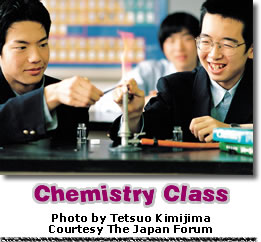 College entrance examination information, practice examination information, upcoming school events, cleaning assignments, and other announcements are posted on the back wall of the classroom. On the front wall, a time schedule is posted.
College entrance examination information, practice examination information, upcoming school events, cleaning assignments, and other announcements are posted on the back wall of the classroom. On the front wall, a time schedule is posted.
A teacher stands in front of a writing board to present the lectures. Teachers at Kitasaga High have their desks in one of four teachers' rooms. Classroom 3-9, like the others at school, is led by a classroom teacher, who must take care of all the students in the room throughout the year — a hard job! My room had so many unique people that our teacher almost gave up on us!
Lots of Requirements....
and Classes on Saturday.
After the school day begins, teachers change classrooms to lecture about a particular subject. Students remain in the same room from lecture to lecture. Spending time with 40 fellow students throughout the school year always helps in the development of social skills. We build wonderful friendships.
 Sometimes, however, students must go to different rooms for their electives. During my senior year, I remained in my classroom most of the time, except during physical education, which is required, and music III, an elective. There were different schedules everyday. For instance, on Monday, my first period was Japanese, but on Tuesday, first period might be Japanese History. Teachers decide classroom schedules at the teachers meeting before the new school year begins.
Sometimes, however, students must go to different rooms for their electives. During my senior year, I remained in my classroom most of the time, except during physical education, which is required, and music III, an elective. There were different schedules everyday. For instance, on Monday, my first period was Japanese, but on Tuesday, first period might be Japanese History. Teachers decide classroom schedules at the teachers meeting before the new school year begins.
During my first grade high school year, I studied English I-A (grammar), English I-B (listening and speaking), Japanese literature, Japanese classic literature (very difficult!), Math I, Introduction to Japanese History, Introduction to World History, Physics, Physical Education, Home Economics, and Music I (elective). Studying for the mid-terms and final exams was so painful!
Monday through Friday we had six class periods each day. On Saturdays we had four periods. Because our country's education department requires students to study so many subjects, we just had to go to school on Saturdays — and in summer, we had only one and a half months of vacation. Recently, Saturdays were dropped from the weekly class calendar (too late for me!).
Events and Competitions
Create New Friendships.
 I was especially fond of our competition festivals when classes competed against one another in sports, art, music, and theatre activities. The Kitasaga High festivals were always fun because of the opportunities to observe other classmates and discover interesting things about them.
I was especially fond of our competition festivals when classes competed against one another in sports, art, music, and theatre activities. The Kitasaga High festivals were always fun because of the opportunities to observe other classmates and discover interesting things about them.
A hiking road about four kilometers in length stretched through the neighborhood near Kitasaga High. It provided a very pretty view of an area designated as one of Kyoto's Important Cultural Properties. We used this road for our annual marathon race in February. I can't recall exactly how many kilometers each classroom had to run as a group, but I do know that every student was assigned to run part of the course. Some might only run a short distance, but others were asked to run the entire four kilometers.
Kitasaga High's physical education class for the months of January and February participated in the 4K marathon, and our running time affected the P.E. grade. It was hard to get an A from P.E., but I really wanted an A, so I ran every morning in January and February before I went to school. Yes, I was so desperate! Usually, students who were members of sports teams were the fast runners, so they were required to run the entire 4K on the annual marathon.
One year, my best time happened to be just a few minutes more than my female sports-team classmates because of my morning run. As a result, I was assigned to run the distance in the annual marathon. During my classroom meeting, I tried to make all kinds of silly excuses not to run. Finally, my classroom teacher said, "Yuki, I have all of your marathon reports, and you are one of the fastest runners in this classroom." I could not believe it!
My classroom finished ninth out of 11, but the result did not matter so much. At our classroom party after the race, my classmates were amazed and laughed at my silly excuses. "I'm allergic to marathon," I said. "Sure," they laughed.
Getting to know my classmates better was the best result of the annual marathon.
Bento at Lunchtime....
Sunomono, Anyone?
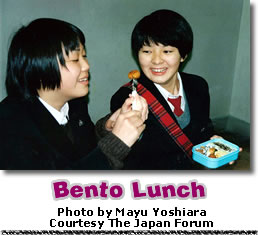 Lunch period began at 12:20 p.m. and ended at one o'clock. A classroom meeting followed until 1:20 p.m. Students eat lunch in their classrooms with friends. I brought "bento," which is a Japanese lunch box, consisting of rice and some other traditional Japanese family food, such as Tonkatsu (Japanese fried pork), Goma-ae (boiled vegetables with sesame seed paste on top), Fried Tofu, Sunomono (pickled cucumber, seaweed, and octopus mix), Baked Salmon, Pickled Plum, and so on.
Lunch period began at 12:20 p.m. and ended at one o'clock. A classroom meeting followed until 1:20 p.m. Students eat lunch in their classrooms with friends. I brought "bento," which is a Japanese lunch box, consisting of rice and some other traditional Japanese family food, such as Tonkatsu (Japanese fried pork), Goma-ae (boiled vegetables with sesame seed paste on top), Fried Tofu, Sunomono (pickled cucumber, seaweed, and octopus mix), Baked Salmon, Pickled Plum, and so on.
It was popular for a girl to prepare a lunch box for her favorite boy or her boyfriend. Unfortunately, I never took the opportunity to prepare a bento for a boy.
My mother prepared my lunch every morning, but sometimes I stopped by a bakery to buy some pastries, breads, and tea for lunch. There were at least five bakeries near my house. My favorite bread was "Japanese Curry Bread." Bakeries are very popular in Japan, especially among high school and college students for their lunch and snacks.
Cleaning Time
Equates to Camaraderie.
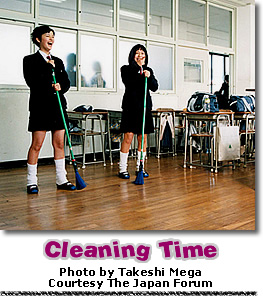 Last period ends at 3:20 p.m., but all students are assigned to clean classrooms, restrooms, and other school facilities for 20 to 30 minutes. Instead of hiring janitors to clean all the rooms, Kitasaga High used student cleaning time to instill discipline and public morals. I never saw trash on the floors at any time during my years at school. Last period ends at 3:20 p.m., but all students are assigned to clean classrooms, restrooms, and other school facilities for 20 to 30 minutes. Instead of hiring janitors to clean all the rooms, Kitasaga High used student cleaning time to instill discipline and public morals. I never saw trash on the floors at any time during my years at school.
Each classroom was assigned to clean three or four places. For instance, my group, 3-9, was responsible for our classroom, the stairs on the third-floor west, and the third-floor restroom. We were divided into four groups; each group cleaned one place for a week, and one group had the week off!
After School We Go
Our Separate Ways.
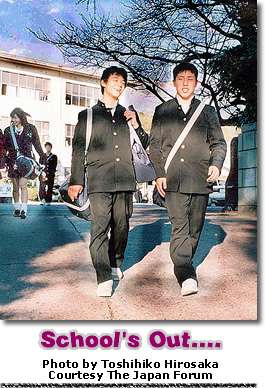 Perhaps 20 to 30 percent of us joined after-school activities. Baseball, soccer, track and field, basketball, volleyball, softball, band, choir, and painting were popular choices.
Perhaps 20 to 30 percent of us joined after-school activities. Baseball, soccer, track and field, basketball, volleyball, softball, band, choir, and painting were popular choices.
The rest of us attended private tutoring schools to study for the college entrance examination.
Because of a limited number of openings in colleges and universities in Japan, students usually begin to prepare for their college entrance examination in their first year of high school. I did not want to study after school, so I joined the band, and devoted all of my energies to music during my high school years.
Being a music student is expensive, and I was also told that I would never be able to earn money from music, so I just gave up on my music dreams. However, during my last year at Kitasaga High, I was accepted for the International Exchange Student Program to study in the U.S.A. My original plan was to complete my exchange studies and apply to a school in Japan that trains stenographers. Instead, after coming to Arkansas and attending Jacksonville High School, I was accepted into UCA with an orchestra scholarship. I am glad I decided not to totally give up on music.
Sweet Memories,
Cherry Petals,
and a Good Friend.
On the path to Kitasaga High is a special street surrounded by cherry blossom trees. Every April, I looked forward to walking or riding my bicycle along this street. I know that other students enjoyed it as well. The smell of cherry blossoms was so fresh and gentle. It touched my heart.
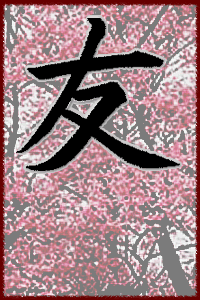 Often a few cherry blossom petals clung to my school uniform, or to my long hair. Today, ten years after my graduation from Kitasaga High, I can smell the blossoms as if it were yesterday.
Often a few cherry blossom petals clung to my school uniform, or to my long hair. Today, ten years after my graduation from Kitasaga High, I can smell the blossoms as if it were yesterday.
I also remember my interesting friends. I remember Mori-Mori (her nickname), a gifted artist who entered university as an art major. She, too, has followed interesting paths. Currently she works as an editor of her town's local newspaper and continues to paint, selling her work as a freelance artist. She is the mother of one beautiful child. I especially remember her delicious vegetable curry, and think of her as the one person who motivated me to become a writer.
If you have any questions or want to share YOUR high school stories, please write me at: tubaroom@hotmail.com
Yukiko Hayata
Graduate Assistant in Bands
Department of Music
University of Central Arkansas, U.S.A.
Planet IEP is ruled by webmistress Freddie A. Bowles, Lecturer in English as a Second Language and German as a Foreign Language at the University of Central Arkansas. She is also Freshman Advisor for the Liberal Arts College at the University. An independent entity in the CornDancer consortium of planets, Planet IEP is dedicated to the study and exploration of the English language, American culture, and life in an American university for international students. Planet IEP also publishes essays and articles in appreciation of cultures from all reaches of Planet Earth. CornDancer is a developmental website for the mind and spirit. Submissions are invited.
|

